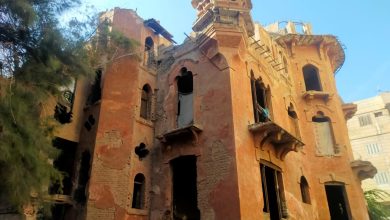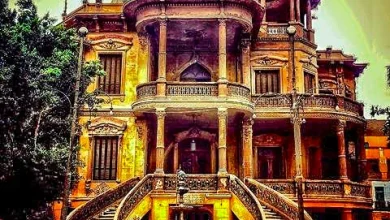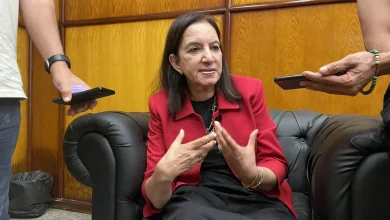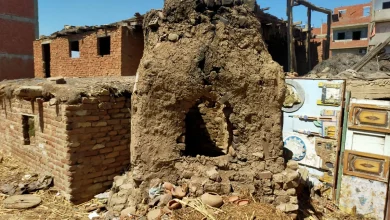
Sustaining the dream.. Women rewrite history in Al-Gharbia
- Women redefining work
- From dream to reality
- A constant desire to succeed
- Threads of hope extend
- The Future Of Possible
On the main rural road in the village of Hannoun, in the center of Zifta in Al-Gharbia governorate, a simple building stands among the fields, but its walls hold the dreams of many women. These dreams are realized every day with more stories of patience, a passion for learning, a desire to preserve heritage, self-affirmation, and a different pulse of life to the rhythm of women’s laughter and vision.
There, at the Istidama Center, a new life is woven every day, just as the women weave pieces of clothing and silk with their hands. The center, which opened in August last year, aims to empower women economically and seeks to support their ambitions to revive the forgotten heritage of the West and rework it with a contemporary spirit.
Istidama Center for Handicrafts and Heritage
When I entered the village, I saw that it was no less simple than other villages in Al-Gharbia. When I entered the center, I did not encounter silent doors and lifeless walls. Instead, I was greeted by introductory signs and press articles about the center framed on the walls, while my nose caught a mixture of the smells of wood and melted copper. The different sounds of tapping on wood mingled with the sound of sewing machines in a charming harmony, like the music of hope.
I saw a long hall with four rooms on either side: on the left, a room for heavy handicrafts and another for light work; On the right, there was a room for textiles and another for teaching modern electronic drawing and graphic design. On the floor above, there was a sewing and embroidery workshop, an exhibition space for the center’s work, and accommodation for trainers and trainees from outside the province.

Women redefining work
The women sat in air-conditioned rooms with simple wooden chairs. Their ages range from 18 and above, their eyes shining with enthusiasm in the crochet and copper workshops I attended. While others are busy embroidering and carving wood, and others are making accessories and weaving macramé, they are learning everything new with genuine enthusiasm.
Nora Ehab, one of the participants in the leather workshop, tells Bab Masr-Bahri that the center represents a different life for her, as it provides them with excellent trainers who taught them honesty and patience before teaching them any craft. She points out that this is the third workshop she has attended, having previously attended crochet and graphic design workshops. Now she is learning how to make leather bags, shoes, and accessories.
Haja Safaa Hamed, one of the center’s pioneers, says that learning sewing, embroidery, and tailoring at the center helped her find a job in a garment factory, even though she is over 40 years old.
From dream to reality
“I noticed that the women here have innate skills in handicrafts. But these skills were dormant and needed someone to revive them. With determination, I tried to motivate them despite their individual differences and varying ages. I had a dream of teaching women in rural areas, and here my dream has become a reality,” crochet instructor Aya Al-Bahiri told Bab Masr-Bahri.
The story repeats itself every day. The center provides the raw materials, and the women leave their unique mark on them. Some even start small projects in their homes afterwards. This is the goal of the center: for its graduates to be able to support themselves and their children.
The Sustainability Center is the first of its kind in the West to teach traditional and handicrafts to women for their economic empowerment. Every day, it welcomes more than 400 women from 10 neighboring villages in Zifta and the governorate to learn skills and crafts. The center targets women between the ages of 18 and 45, and each workshop has two levels, beginner and advanced. Each woman is paid 100 pounds per class, according to Suad Ibrahim, general supervisor of activities and workshops at the center.
The center aims to provide 400 direct job opportunities annually for 400 women breadwinners from the village of Hanoun and neighboring villages. It also aims to provide 1,000 indirect job opportunities as part of a sustainable vision that takes into account environmental conservation.

A constant desire to succeed
Esraa Abdel Mawgoud, one of the trainees in the copper workshop, always makes sure that her day is filled with work. She focuses on the small details that give her life meaning.
She tells Bab Masr-Bahri that “sustainability” has given her life meaning after graduation. She works in a field she loves and believes in: making copper accessories. She sees the center as a source of hope that is renewed every morning.
Abdul Mawjoud adds that her work and training here do not affect her personal or social life. Although she spends most of her day here, from 9 a.m. to 5 p.m., her personal life has not been affected. She is able to do all her activities alongside learning the craft. She says that her hope is to open her own exhibition soon.
Even the center’s guard considers the women here to be fighters. It is the first time he has felt proud of the women in his village, because they have overcome their fear and are eager to learn. The growing demand for workshops every day gives him hope that the center will fulfill its role and more. He sees “the sun shining on his country” through its women who preserve its heritage.
Threads of hope extend
At the end of my tour, I realized that hope began with a small idea among the villagers to eliminate unemployment. Between ambitions to launch a production line for selling textiles and other hopes for the revival of the villages and the preservation of their crafts, threads of hope were spinning a future full of determination, preserving the independence of heritage and the uniqueness of Egyptian arts. They are working diligently to preserve their identity.
In this part of Gharbia, I realized that women’s hearts are big enough to become storytellers of heritage once again. But with strong voices, not fictional folk tales. I found that this center is a new beginning for building different cultural features, smiles, and voices.
Read also
When roads become a means of survival… Stories from the heart of “Tel Al-Haddadin” in Tanta





Hi, this is a comment.
To get started with moderating, editing, and deleting comments, please visit the Comments screen in the dashboard.